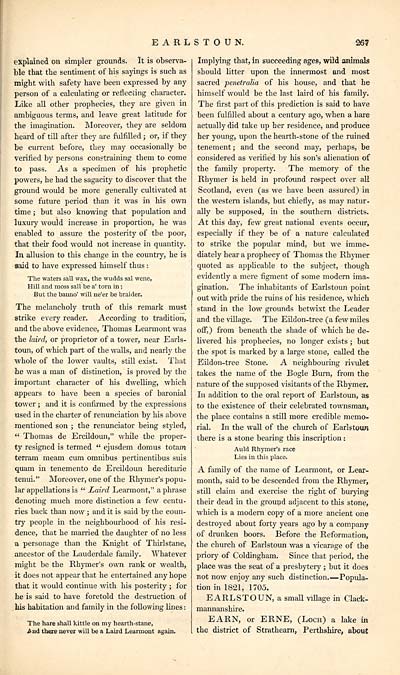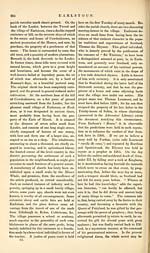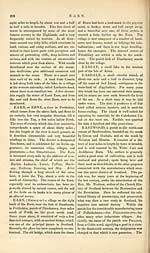Gazetteer of Scotland > Volume 1
(299) Page 267
Download files
Complete book:
Individual page:
Thumbnail gallery: Grid view | List view

EARLSTOUN.
267
explained on simpler grounds. It is observa-
ble that the sentiment of his sayings is such as
might with safety have been expressed by any
person of a calculating or reflecting character.
Like all other prophecies, they are given in
ambiguous terms, and leave great latitude for
the imagination. Moreover, they are seldom
heard of till after they are fulfilled ; or, if they
be current before, they may occasionally be
verified by persons constraining them to come
to pass. As a specimen of his prophetic
powers, he had the sagacity to discover that the
ground would be more generally cultivated at
some future period than it was in his own
time ; but also knowing that population and
luxury would increase in proportion, he was
enabled to assure the posterity of the poor,
that their food would not increase in quantity.
In allusion to this change in the country, he is
said to have expressed himself thus :
The waters sail wax, the wudds sal wene,
Hill and moss sail be a' torn in ;
But the bauno' will ne'er be braider.
The melancholy truth of this remark must
strike every reader. According to tradition,
and the above evidence, Thomas Learmont was
the laird, or proprietor of a tower, near Earls-
toun, of which part of the walls, and nearly the
whole of the lower vaults, still exist. That
he was a man of distinction, is proved by the
important character of his dwelling, which
appears to have been a species of baronial
tower ; and it is confirmed by the expressions
used in the charter of renunciation by his above
mentioned son ; the renunciator being styled,
" Thomas de Ercildoun," while the proper-
ty resigned is termed " ejusdem domus totam
terram meam cum omnibus pertinentibus suis
quam in tenemento de Ercildoun hereditarie
tenui." Moreover, one of the Rhymer's popu-
lar appellations is " Laird Learmont," a phrase
denoting much more distinction a few centu-
ries back than now ; and it is said by the coun-
try people in the neighbourhood of his resi-
dence, that he married the daughter of no less
a personage than the Knight of Thirlstane,
ancestor of the Lauderdale family. Whatever
might be the Rhymer's own rank or wealth,
it does not appear that he entertained any hope
that it would continue with his posterity ; for
he is said to have foretold the destruction of
his habitation and family in the following lines:
The hare shall kittle on my hearth-stane,
And there never will be a Laird Learmont again.
Implying that, in succeeding ages, wild animals
should litter upon the innermost and most
sacred penetralia of his house, and that he
himself would be the last laird of his family.
The first part of this prediction is said to have
been fulfilled about a century ago, when a hare
actually did take up her residence, and produce
her young, upon the hearth-stone of the ruined
tenement ; and the second may, perhaps, be
considered as verified by his son's alienation of
the family property. The memory of the
Rhymer is held in profound respect over all
Scotland, even (as we have been assured) in
the western islands, but chiefly, as may natur-
ally be supposed, in the southern districts.
At this day, few great national events occur,
especially if they be of a nature calculated
to strike the popular mind, but we imme-
diately hear a prophecy of Thomas the Rhymer
quoted as applicable to the subject, though
evidently a mere figment of some modern ima-
gination. The inhabitants of Earlstoun point
out with pride the ruins of his residence, which
stand in the low grounds betwixt the Leader
and the village. The Eildon-tree (a few miles
off,) from beneath the shade of which he de-
livered his prophecies, no longer exists ; but
the spot is marked by a large stone, called the
Eildon-tree Stone. A neighbouring rivulet
takes the name of the Bogle Burn, from the
nature of the supposed visitants of the Rhymer.
In addition to the oral report of Earlstoun, as
to the existence of their celebrated townsman,
the place contains a still more credible memo-
rial. In the wall of the chinch of Earlstoun
there is a stone bearing this inscription :
Auld Rhymer's race
Lies in this place.
A family of the name of Learmont, or Lear-
month, said to be descended from the Rhymer,
still claim and exercise the right of burying
their dead in the ground adjacent to this stone,
which is a modern copy of a more ancient one
destroyed about forty years ago by a company
of drunken boors. Before the Reformation,
the church of Earlstoun was a vicarage of the
priory of Coldingham. Since that period, the
place was the seat of a presbytery ; but it does
not now enjoy any such distinction. — Popula-
tion in 1821, 1705.
EARLSTOUN, a small village in Clack-
mannanshire.
EARN, or ERNE, (Loch) a lake in
the district of Strathearn, Perthshire, about
267
explained on simpler grounds. It is observa-
ble that the sentiment of his sayings is such as
might with safety have been expressed by any
person of a calculating or reflecting character.
Like all other prophecies, they are given in
ambiguous terms, and leave great latitude for
the imagination. Moreover, they are seldom
heard of till after they are fulfilled ; or, if they
be current before, they may occasionally be
verified by persons constraining them to come
to pass. As a specimen of his prophetic
powers, he had the sagacity to discover that the
ground would be more generally cultivated at
some future period than it was in his own
time ; but also knowing that population and
luxury would increase in proportion, he was
enabled to assure the posterity of the poor,
that their food would not increase in quantity.
In allusion to this change in the country, he is
said to have expressed himself thus :
The waters sail wax, the wudds sal wene,
Hill and moss sail be a' torn in ;
But the bauno' will ne'er be braider.
The melancholy truth of this remark must
strike every reader. According to tradition,
and the above evidence, Thomas Learmont was
the laird, or proprietor of a tower, near Earls-
toun, of which part of the walls, and nearly the
whole of the lower vaults, still exist. That
he was a man of distinction, is proved by the
important character of his dwelling, which
appears to have been a species of baronial
tower ; and it is confirmed by the expressions
used in the charter of renunciation by his above
mentioned son ; the renunciator being styled,
" Thomas de Ercildoun," while the proper-
ty resigned is termed " ejusdem domus totam
terram meam cum omnibus pertinentibus suis
quam in tenemento de Ercildoun hereditarie
tenui." Moreover, one of the Rhymer's popu-
lar appellations is " Laird Learmont," a phrase
denoting much more distinction a few centu-
ries back than now ; and it is said by the coun-
try people in the neighbourhood of his resi-
dence, that he married the daughter of no less
a personage than the Knight of Thirlstane,
ancestor of the Lauderdale family. Whatever
might be the Rhymer's own rank or wealth,
it does not appear that he entertained any hope
that it would continue with his posterity ; for
he is said to have foretold the destruction of
his habitation and family in the following lines:
The hare shall kittle on my hearth-stane,
And there never will be a Laird Learmont again.
Implying that, in succeeding ages, wild animals
should litter upon the innermost and most
sacred penetralia of his house, and that he
himself would be the last laird of his family.
The first part of this prediction is said to have
been fulfilled about a century ago, when a hare
actually did take up her residence, and produce
her young, upon the hearth-stone of the ruined
tenement ; and the second may, perhaps, be
considered as verified by his son's alienation of
the family property. The memory of the
Rhymer is held in profound respect over all
Scotland, even (as we have been assured) in
the western islands, but chiefly, as may natur-
ally be supposed, in the southern districts.
At this day, few great national events occur,
especially if they be of a nature calculated
to strike the popular mind, but we imme-
diately hear a prophecy of Thomas the Rhymer
quoted as applicable to the subject, though
evidently a mere figment of some modern ima-
gination. The inhabitants of Earlstoun point
out with pride the ruins of his residence, which
stand in the low grounds betwixt the Leader
and the village. The Eildon-tree (a few miles
off,) from beneath the shade of which he de-
livered his prophecies, no longer exists ; but
the spot is marked by a large stone, called the
Eildon-tree Stone. A neighbouring rivulet
takes the name of the Bogle Burn, from the
nature of the supposed visitants of the Rhymer.
In addition to the oral report of Earlstoun, as
to the existence of their celebrated townsman,
the place contains a still more credible memo-
rial. In the wall of the chinch of Earlstoun
there is a stone bearing this inscription :
Auld Rhymer's race
Lies in this place.
A family of the name of Learmont, or Lear-
month, said to be descended from the Rhymer,
still claim and exercise the right of burying
their dead in the ground adjacent to this stone,
which is a modern copy of a more ancient one
destroyed about forty years ago by a company
of drunken boors. Before the Reformation,
the church of Earlstoun was a vicarage of the
priory of Coldingham. Since that period, the
place was the seat of a presbytery ; but it does
not now enjoy any such distinction. — Popula-
tion in 1821, 1705.
EARLSTOUN, a small village in Clack-
mannanshire.
EARN, or ERNE, (Loch) a lake in
the district of Strathearn, Perthshire, about
Set display mode to: Large image | Transcription
Images and transcriptions on this page, including medium image downloads, may be used under the Creative Commons Attribution 4.0 International Licence unless otherwise stated. ![]()
| Gazetteers of Scotland, 1803-1901 > Gazetteer of Scotland > Volume 1 > (299) Page 267 |
|---|
| Permanent URL | https://digital.nls.uk/97427950 |
|---|
| Description | Volume I: Abbey to Glenartney. |
|---|---|
| Attribution and copyright: |
|
| Description | By Robert Chambers and William Chambers. Glasgow: Blackie & Son, 1838. 2 volumes. |
|---|---|
| Shelfmark | NF.1461.g.7 |
| Additional NLS resources: | |

